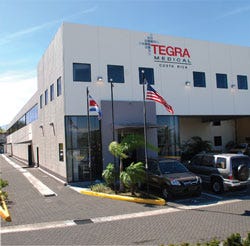Medical device contract manufacturers have made at least 16 cross-border acquisitions in the past 12 months.
July 30, 2012

Consolidation among contract manufacturers serving the medical device industry is nothing new, but recently medtech outsourcers have been buying up firms overseas in attempts to help their OEM customers cut costs and expand into new markets.
|
Medical device contract manufacturer Tegra Medical purchased this facility in San Jose, Costa Rica, in 2010. |
The trend has been gaining momentum over the past three or four years, says Mark Surowiak, a director in the Philadelphia office of Capstone Partners, an investment banking advisory firm. He cites 16 overseas acquisitions by medical device contract manufacturers in the past 12 months as evidence that the practice is continuing in 2012.
“Domestic players are continuing to acquire overseas, and firms in overseas countries still are trying to gain a foothold in the U.S. market,” Surowiak says. Companies based in the Netherlands, Italy, and Ireland have been especially active in acquiring medtech outsourcing firms in the United States, while companies in China, Brazil, India, and Latin America have been popular targets for U.S. contract manufacturers, he says.
Two years ago, medical device contract manufacturer Tegra Medical (Franklin, MA) bought a 20,000-sq-ft manufacturing plant in San Jose, Costa Rica, in an effort to cut costs for its OEM customers.
“When products mature, price pressures increase, and you need to take cost out of products every year,” says Tom Burns, vice president of development for the company. “At some point, you run out of options domestically.”
The facility, which Tegra Medical purchased from Penn United Technologies, was a good fit for the company for a number of reasons, Burns says. Its general manager was bilingual, originally from the United States, and had relevant experience; the plant already had a good technical staff and about 10 toolmakers; and it came with basic manufacturing capabilities and equipment.
Tegra Medical chose the facility in Costa Rica over others in Central America largely because it is located in a tax-free trade zone that is also home to several other medical manufacturing companies. That has allowed the company to react quicker and reduce shipping costs, and enables its customers to carry less inventory.
Overall, Burns says the facility in Costa Rica has helped Tegra Medical reduce labor and overhead costs, but Surowiak says cost cutting isn’t the only factor driving contract manufacturers to make overseas acquisitions. The trend can be attributed in part to a broader shift toward consolidation in contract manufacturing. As medtech OEMs outsource more of their operations, they’re looking for contractors that offer a wide range of capabilities, Surowiak says. Outsourcers have responded by making acquisitions to boost their portfolio of services and increase their global footprint.
All of this has resulted in an evolving relationship between OEMs and their contract manufacturing partners. “OEMs now look to contract manufacturers as partners, and they want to explore new market opportunities with their existing vendors,” Surowiak says.
Many of those opportunities are in emerging economies, where reimbursement rates for medical devices are typically lower than in the United States and Europe. To compensate, OEMs are working with contract manufacturers to build scaled-down versions of their products closer to where they will be distributed, Surowiak says. Regulations can make it difficult for outsourcers to build operations from scratch in developing countries, so outsourcers are acquiring firms in their target markets instead.
“You are seeing more of it as there’s more recognition of emerging markets being a significant growth opportunity,” Surowiak says.
But while working with a contract manufacturer with a presence around the world can hold benefits for OEMs, there are downsides, including delays.
“It’s not as easy to get equipment serviced in Costa Rica or other countries outside the U.S.,” Burns says. “It can add days or a week or more if you have a problem with equipment or need spare parts.”
Foreign facilities also often need to be brought into compliance with relevant standards, and that can take time. In some cases, language barriers must be overcome, and in countries such as China, intellectual property protection can be a concern. If secondary operations, such as sterilization, aren’t available in the new country, the product will have to be shipped elsewhere to have them performed, which increases costs. There’s also availability of labor and political stability to consider.
Burns says some of Tegra Medical’s customers took a wait-and-see approach before using the new Costa Rica facility, in some cases holding off until the plant was up and running for six months before performing an audit of their own. Others were eager to move operations there.
The bottom line: Using an offshore outsourcing operation is not right for every company or every product.
“OEMs have to do their homework and really look at the true delivered cost and what they’ll have to invest in resources on their end,” before working with an outsourcer to move production across borders, Burns says.
—Jamie Hartford is the associate editor of MD+DI. Follow her on Twitter @readMED.
About the Author(s)
You May Also Like



